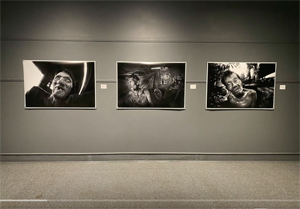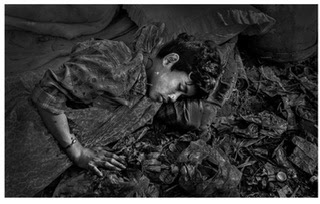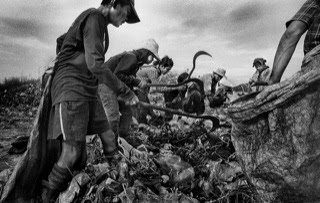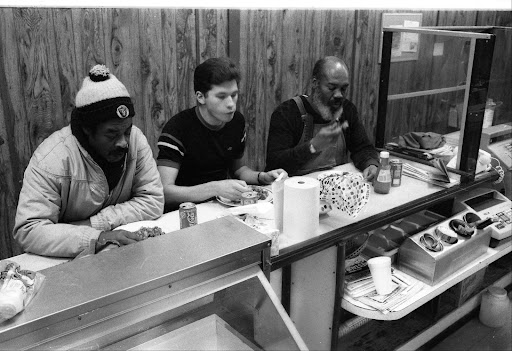
Byline: Robin McDowell Associated Press Associated Press: see news agency.
--------------------------------------------------------------------------------
Associated Press (AP)
For 10,000 people, stepping before the camera was a step toward the grave. Some days, hundreds gazed forlornly into the lens, many en route to horrible torture before execution.
Nhem Ein held the chunky Canon. He focused on their faces. He heard their screams. He said nothing.
``One day, I saw the face of a close relative through my camera,'' he now recalls. ``I kept silent even after he was taken to be interrogated and then killed.''
Nhem Ein was chief photographer at Phnom Penh's infamous Tuol Sleng torture center during the rule of the Khmer Rouge name given to native Cambodian Communists. Some 20,000 people passed through Tuol Sleng's bloody chambers before being trucked to the Choeung Ek killing field 10 miles outside the capital and bludgeoned to death.
A fraction of the photographer's grim black-and-white mug shots have stared for years from the walls of Tuol Sleng, turned into a genocide museum when Vietnam drove out the Khmer Rouge in 1979.
But until a few months ago, the man who took the photos, this prime witness to Cambodia's profound nightmare, was a mystery. It turns out the photographer was just a 16-year-old boy, though a trusted Khmer Rouge veteran, when he started his grisly task.
Nhem Ein, now 37, is one of thousands of war-weary guerrillas to have abandoned the Khmer Rouge's northern jungle strongholds and defected in the past year.
The story he told The Associated Press last week of his time at Tuol Sleng adds an eerie footnote to the anonymous portraits on the walls.
``It was incredible to meet the person who took all these pictures,'' said Douglas Niven, an American photographer who spent three years helping clean and catalog 6,000 negatives found in forgotten drawers at the prison, covered in fungus and dirt. ``Anyone who has been to the Tuol Sleng museum just cannot forget them.''
At Tuol Sleng, officially known as the S-21 interrogation center.
``They used many ways, such as taking a clamp to pull out a nail, or using an electric shock on the tongue to force confessions,'' Nhem Ein said.
The cries and screams were constant.
Nhem Ein recalls seeing face after face filled with fear and ``deep sadness.''
``Those who arrived at the facility had no chance of living,'' he said. Only seven of the 20,000 prisoners are known to have survived. In all, Nhem Ein figures he took about 10,000 photographs.
``I took pictures of the prisoners just after they had a number pinned on them,'' Nhem Ein said. ``The photos were taken before they were interrogated or tortured.''
Cambodian scholars had long wondered why many prisoners wore the same number. Nhem Ein said the numbering system began anew every 12 hours. No. 1 was pinned on a prisoner at 1 a.m. At 12:59 p.m., the number might be 100 or 150 or 225. At 1 p.m., it was back to 1.
``I and three others were able to develop and print the pictures. We did this every day,'' he said. ``I took hundreds of photographs at a time, sometimes thousands.''
Nhem Ein was just 10 when he joined the Khmer Rouge, shortly after Gen. Lon Nol Lon Nol, 1913–85, Cambodian general and political leader. His mother had died when he was 2, and his father, a poor bean farmer, struggled to raise eight boys.
The teen-ager was sent to Shanghai, China, for training as a photographer, filmmaker and cartographer. He returned in May 1976 to be named chief photographer at Tuol Sleng, in charge of five apprentices.
The number of prisoners arriving at S-21 increased dramatically the following year, when Khmer Rouge purges intensified. Up to 600 people were delivered each day, Nhem Ein said.
``I knew that I was taking the pictures of innocent people, but I knew that if I said anything, I would be killed,'' Nhem Ein said.
Son Sen, who had overall responsibility for internal security, visited Tuol Sleng as often as once a week, Nhem Ein said. Pictures of important people - before and after execution - were sent to him and Pol Pot as proof they had been killed.
After the Vietnamese invasion, Nhem Ein took pictures for a Khmer Rouge newsletter. He said he'd lost faith in the revolution by mid-1977 but feared leaving his comrades and being killed by the Vietnamese.
Besides Nhem Ein's photographs, the Tuol Sleng museum also displays skulls and clothing of Khmer Rouge victims, primitive torture chambers where people were shackled to iron beds and some of the absurd confessions extracted under torture.
Only once, Nhem Ein said, did he see a face he knew in the viewfinder, a 25-year-old cousin named Chhan, whom the Khmer Rouge accused of spying for the CIA.
``I went back to Tuol Sleng in October to see if I could find his picture, but it was missing,'' Nhem Ein said last week. ``Being there made me feel very, very sad.


















